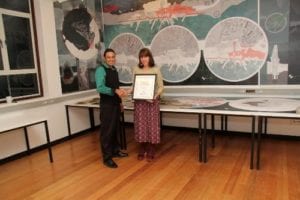UCT Corobrik Architectural Student of the year winner’s design of a desalination and salt harvesting plant helps alleviate water scarcity.
A desalination plant in Hout Bay, able to produce 30 000M ℓ/day of potable water, situated on the edge of the industrial sector, harbour, the informal settlement of Hangberg and the beginning the mountainous terrain of The Sentinel. Incorporated are sustainable energy devices to help supplement this extensive energy consuming process.”
With great infrastructure comes great responsibility, therefore the design of this infrastructure must be coupled with public activities. Building something that helps our future livelihood must be something that people can also interact with, and identify with, thereby creating a physical and emotive landmark. Second placed Christo van der Hoven’s thesis is entitled, “Tunnel vision” in which he investigates infrastructural opportunism through an architectural lens. He investigates the anthropology, architecture and engineering associations of a four kilometre Huguenot tunnel between Paarl and Worcester in the Western Cape was selected in which a mushroom farm can engage with its subterranean context. Simon Tollman’s thesis ‘Life in the Cracks: Architecture in the space left over between adjacent city buildings. Tollman states that regulations govern forms cities take. Their indiscriminate application cause ‘leftover’ spaces between buildings. Separate buildings accessed from a public thoroughfare were inserted, attached parasitically to buildings that flank the site. Behaviours characteristic of city life were accommodated – living, working, eating, outdoor recreation, civic socialisation, and parking – and explored within the constraints of the site. Robert Bown received a special award for the best use of clay brick in his thesis entitled ‘The world according to Graaff’ in which a ruined and forgotten building is rediscovered by energy company G.I.E.C. They see the similarities between their intentions and those held by David Graaff and realise the marketing potential of his legacy. A cooling plant and public bathing facility is built within the ruins on the foreshore. In order to achieve the romance, mystery and intrigue of Victorian ruins clay bricks have been incorporated into the design. The national winner, to be chosen from the eight institutional winners participating, will be announced and presented with a cheque for R50 000 at the 27th National Student Architect awards function in Johannesburg in April 2014. “Corobrik has continued to make advancements in its ongoing drive towards sustainability,” said van Niekerk. “Among these are the uses of energy efficient and environmentally responsible operating systems underpinned by SANS 14001 Environmental Management System certification and through the Clay Brick Association the commissioning of research, technical projects and a full Life Cycle Assessment to advance the cause of masonry walling as an imminently sustainable and appropriate, cost effective construction method for South Africa.” “Architectural students need to be aware of how easy it is to achieve sustainable and energy efficient architecture with clay brick and of course the new technologies that are being continuously developed and able to mitigate the impacts of built structures on the environment, so that these can be incorporated seamlessly into their designs going forward.”







